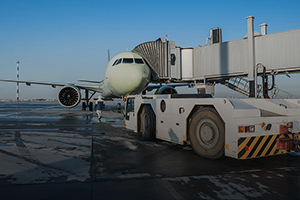Towing System for Airplanes

Runway taxiing burns up huge amounts of fuel each year. It’s been estimated that up to five percent of the aircraft fuel consumed is used while the plane is still on the ground. Now a prototype system has been developed that uses electro-hydraulic powered pull cars and an underground channel system to tow airplanes back and forth between the gate and the runway.
Called the Aircraft Towing System (ATS), it consists of a series of trench-like channels about four feet in width and covered with a steel plate. Inside the trench, pull cars run along a monorail, while above ground, a towing dolly attaches to the plane’s nosewheel and then to the pull car through a slit in the steel plate. Software integrated into the ground control system and managed by tower personnel automatically controls movements of the plane during taxiing and gate operations; however, the pilot can always override ATS in the event of an emergency.
In addition to reducing fuel consumption and emissions, ATS can actually increase throughput by an estimated 30 percent while improving safety by optimizing traffic. Although the installation cost is substantial, the benefits are huge. As an example, it would likely cost about $150 million to install ATS at Chicago O’Hare Airport, but airlines could save up to $500 million in fuel costs in a single year. Other benefits include reduced manpower, shorter taxi times, lower noise levels and safer operation during adverse weather conditions such as rain, fog, ice and snow. A prototype system is currently being installed at Ardmore Industrial Airpark in Oklahoma and is expected to be completed in April.
For information: ATS World Wide LLC, 620 General Drive, Suite 3, Ardmore Airpark, OK 73034; phone: 405-694-9861; website: https://aircrafttowingsystems.com/